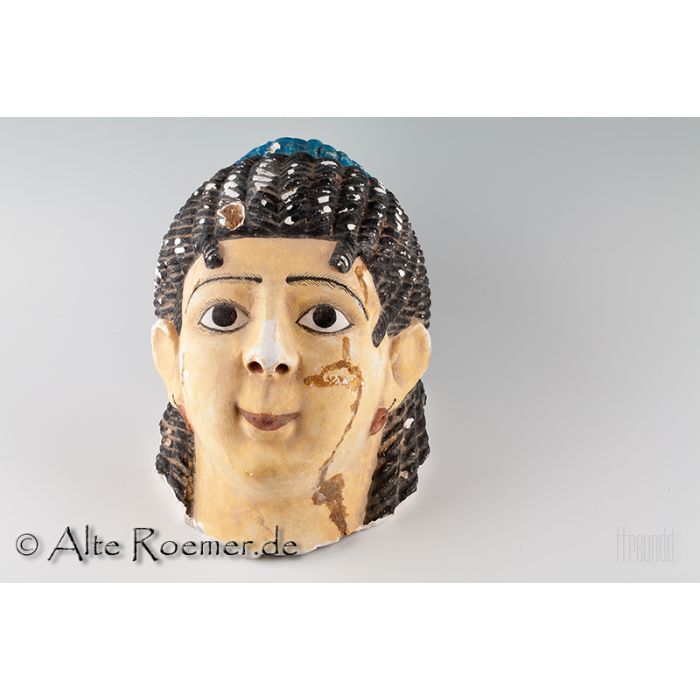Richly painted Ancient Egyptian stucco mask of a lady
€7,400
available
Object number
AR1976
| Object: | Egyptian stucco mask of a woman |
| Material: | White stucco with polychrome paint |
| Period: | 2nd cent. AD Roman Egypt |
| Dimensions: | 28cm length of the face, 16cm width, 18cm depth |
| Description: | Plastic mask of a woman of high status. Worked in great detail. The hollow mask of stucco, sometimes also called mummy mask, was removed from a sarcophagos at the rear head and neck. The rest of the head bears an ideally formed face that was painted in a naturalistic way. It is the face of a young woman. Narrow mouth with dimples to both sides. Small lips, painted in red and raised to a smile. Small and broad nose with fully modelled nares. The eyes are almond shaped and bear a black iris and pupil on white ground. The eyes are bordered by a black rim. Fine black strokes pointing outwards make up the eyelashes. The eyebrows are composed of two black lines which are horizontal around the nose and lower down towards the sides. Fine black strokes, just like for the eyelashes, mark individual hairs of the eyebrows. The lady wears a black wig with finely modeled curls. Four streaks fall on her forehead. The back of her head is fully covered by the rear part of the wig. The headdress is crowned by a turquoise-blue ribbon woven in her hair like a circle with a crosswise bar. The ears are uncovered by hair and each is adorned by an earring. Each earring is painted as a black chain holding a ring shaped pendant coloured like amber. It might represent gold. What is truely special about the mask is the high quality painted life-like portrait. The incredibly good state of preservation lifts this mask above the very select group of facial masks surviving the millenia. Thanks to the dry desert climate of Egypt the paint is still vivid and colourful. |
| Remarks: | Stucco masks like this were part of a mummy burial in Roman Egypt. They were cast in forms and then elaborately reworked and painted. In the final step, the mask was combined with other parts to resemble a full body mounted on the lid of a wooden coffin containing the mummy. It was a life-like image of the laid deceased. The head was inclined towards the chest, the hands were folded. This tradition during Roman Imperial times goes back to earlier Egyptian traditions of trying to achieve imortality for the deceases by remodelling him or her in detail. The use of stucco masks for that purpose started shortly after the Roman occupation of Egypt and lasted until the 3rd century AD. The head was modelled in a position with the chin closer to the chest from the 2nd century onward and that required the mask to be more plastic. Most of the egyptian stucco masks that survived until today originate in burial chambers built of brick in Roman Imperial times. The exact findspots are rarely known, but there is a noticible accumulation in Middle Egypt. |
| Condition: | Great condition with remarkably well-preserved paint. Small chips accross the head (cf. foto). One restored and stable crack along the right half of the face. Border from the separation from the coffin lid on the rear head and neck. There is a pencil mark on the inside "G... Pear 1927". This is a great example of an Egyptian stucco mask in museum quality! |
| Provenance: | Acquired in 2013 from G. Vandervort. Previously, for three generations, in an English private collection. Acquired for this collection in the 1930ies to 1950ies. The pencil mark indicates that the mask was with a G. Pear in 1927. The stucco mask was Lot 38 of the Christie's auction 5488 in 2010 (estimate 5000 GBP to 7000 GBP), but was retracted by the consignor. |
| References: | Published in Christie's Antiquities, Thursday 7 October 2010 (London, South Kensington), Lot 38. A similar mask sold in Christie's Sale 6060 as Lot 113 for 13750 GBP. Cf. S. Walker, M. Bierbrier: Ancient Faces, Mummy Portraits from Roman Egypt (Part IV of the Catalogue of Roman Portraits in the British Museum), page 140, no. 150. Cf. E. Brunner-Traut, H. Bunner, J. Zick-Nissen: Osiris, Kreuz und Halbmond. Die drei Religionen Ägyptens, page 154, no. 129. There, reference to Heidelberg, Ägyptologisches Institut der Universität, 6. |
| Literature: | S. Walker, M. Bierbrier: Ancient Faces, Mummy Portraits from Roman Egypt (Part IV of the Catalogue of Roman Portraits in the British Museum), page 131ff. |
| Auithenticity: | We unconditionally guarantee the authenticity of every artefact, all items are subject to our lifetime return policy on authenticity. |


